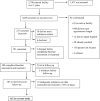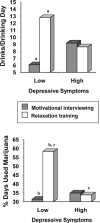Motivational interviewing for incarcerated adolescents: effects of depressive symptoms on reducing alcohol and marijuana use after release
- PMID: 21513687
- PMCID: PMC3084364
- DOI: 10.15288/jsad.2011.72.497
Motivational interviewing for incarcerated adolescents: effects of depressive symptoms on reducing alcohol and marijuana use after release
Abstract
Objective: Motivational interviewing to reduce alcohol and marijuana use among incarcerated adolescents was evaluated.
Method: Adolescents (N = 162, 84% male; M = 17.10 years old) were randomly assigned to receive motivational interviewing or relaxation training, with follow-up assessment 3 months after release.
Results: Compared with those who received relaxation training, adolescents who received motivational interviewing had lower rates of alcohol and marijuana use at follow-up, with some evidence for moderating effects of depression. At low levels of depression, adolescents who received motivational interviewing had lower rates of use. Adolescents who received relaxation training and who had high levels of depressive symptoms early in incarceration showed less use at follow-up than those low in depressive symptoms who received relaxation training.
Conclusions: This brief motivational interviewing intervention during incarceration reduces alcohol and marijuana use after release. In addition, depressive symptoms early in incarceration should be considered in treating these adolescents, but more work is needed to extend follow-up period and account for the impact of depression on outcomes.
Figures
References
-
- Babor TF, Webb C, Burleson JA, Kaminer Y. Subtypes for classifying adolescents with marijuana use disorders: Construct validity and clinical implications. Addiction. 2002;97:58–69. - PubMed
-
- Bardone AM, Krahn DD, Goodman BM, Searles JS. Using interactive voice response technology and timeline follow-back methodology in studying binge eating and drinking behavior: Different answers to different forms of the same question? Addictive Behaviors. 2000;25:1–11. - PubMed
-
- Barrett H, Slesnick N, Brody JL, Turner CW, Peterson TR. Treatment outcomes for adolescent substance abuse at 4- and 7-month assessments. Journal of Consulting and Clinical Psychology. 2001;69:802–813. - PubMed
-
- Bein TH, Miller WR, Boroughs JM. Motivational interviewing with alcohol outpatients. Behavioural Psychotherapy. 1993;21:347–356.
Publication types
MeSH terms
Grants and funding
LinkOut - more resources
Full Text Sources
Medical



